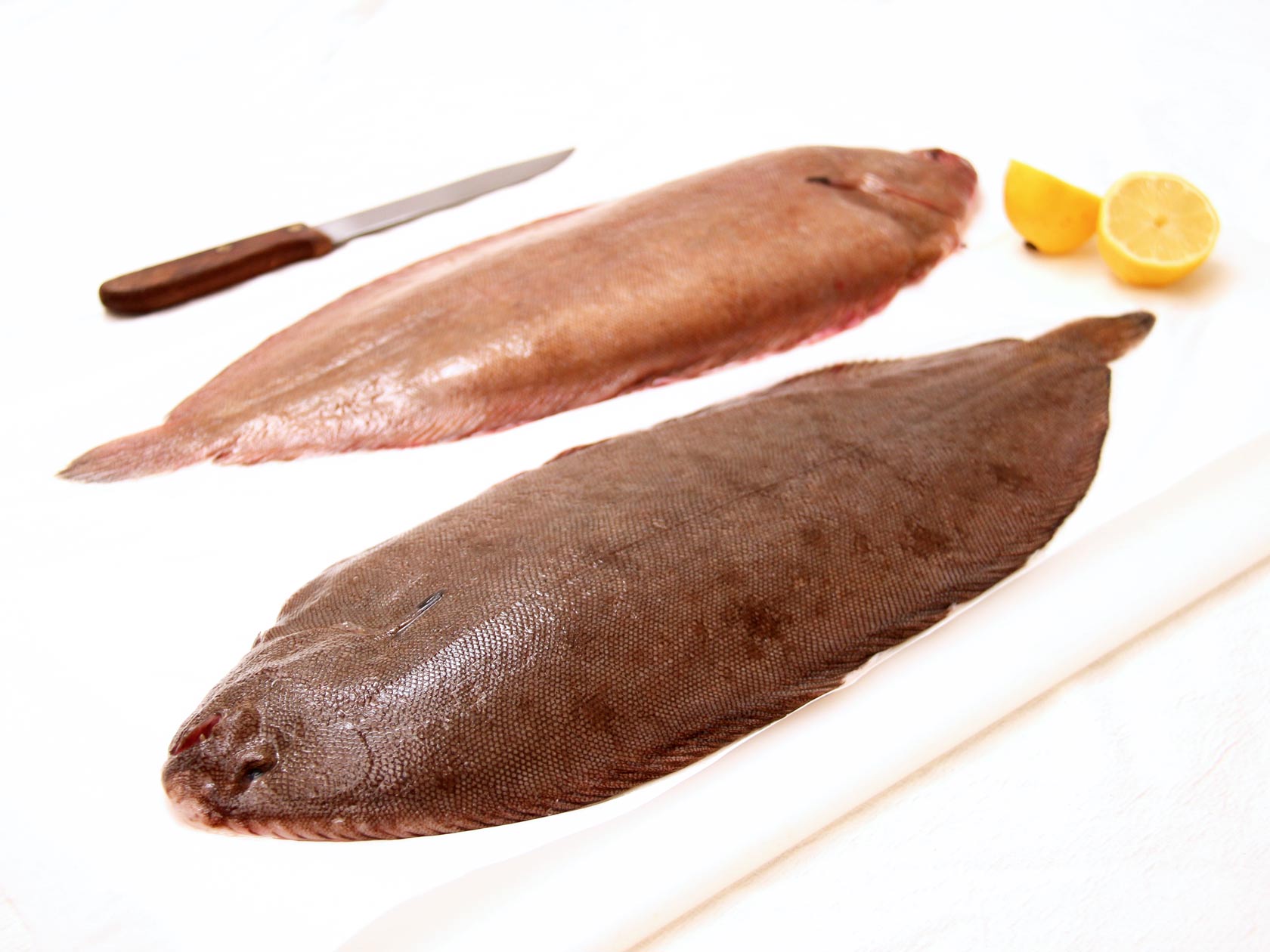Sole Fish Biology and Characteristics

Sole fish are fascinating creatures that inhabit the sandy or muddy bottoms of oceans and seas. They are characterized by their unique physical attributes and adaptations that enable them to thrive in their marine environment.
Physical Attributes
Sole fish have flat, oval-shaped bodies that are asymmetrical, with one side facing upwards and the other facing downwards. Their eyes are located on the upper side of their heads, which gives them a distinctive appearance. They have a dark or mottled coloration on their upper side, which helps them camouflage with the seafloor. Their undersides are usually white or cream-colored.
Adaptations, Sole fish
Sole fish have adapted to their bottom-dwelling lifestyle in several ways. Their flattened bodies allow them to swim close to the seafloor and easily bury themselves in the sand or mud for protection from predators. They also have a special organ called a swim bladder that helps them maintain their position in the water column.
Habitat
Sole fish are found in various marine habitats, including shallow coastal waters, estuaries, and deeper offshore waters. They prefer sandy or muddy bottoms where they can easily bury themselves. Some species are even found in brackish waters.
Feeding Habits
Sole fish are carnivorous and feed primarily on small invertebrates, such as worms, crustaceans, and mollusks. They use their keen eyesight to locate prey and then ambush them from the seafloor.
Lifespan
The lifespan of sole fish varies depending on the species. Some species, such as the common sole, can live for up to 50 years, while others have shorter lifespans.
Species and Distribution
There are numerous species of sole fish found in oceans and seas worldwide. Some of the most common species include:
- Common sole (Solea solea): Found in the eastern Atlantic Ocean and the Mediterranean Sea.
- Dover sole (Microstomus pacificus): Found in the eastern Pacific Ocean from Alaska to California.
- Lemon sole (Parophrys vetulus): Found in the eastern Pacific Ocean from Alaska to Baja California.
- Sand sole (Psettichthys melanostictus): Found in the eastern Pacific Ocean from Alaska to California.
- Yellowfin sole (Limanda aspera): Found in the North Atlantic Ocean and the Arctic Ocean.
Culinary Applications of Sole Fish

The culinary value of sole fish is undeniable, with its delicate flavor and versatile texture making it a favorite in various cuisines around the world. The mild taste and firm yet tender flesh of sole fish allow it to be prepared in a myriad of ways, from simple pan-frying to elegant sauces and complex dishes.
Sole fish is a highly versatile fish that can be cooked using various techniques. Pan-frying is a popular method that results in a crispy exterior and a moist, flaky interior. Sole fish can also be baked, grilled, or steamed, each method yielding distinct flavors and textures. For a more flavorful experience, sole fish can be marinated in herbs, spices, or citrus juices before cooking.
Recipes
- Pan-Fried Sole with Lemon Butter Sauce
- Ingredients:
- 1 pound sole fillets
- 1/4 cup flour
- 1/4 cup butter
- 1/4 cup lemon juice
- 1/4 cup chopped parsley
- Instructions:
- Dredge sole fillets in flour.
- Heat butter in a skillet over medium heat.
- Pan-fry sole fillets for 3-4 minutes per side, or until golden brown and cooked through.
- Remove sole fillets from the skillet and set aside.
- Add lemon juice to the skillet and bring to a boil.
- Reduce heat and simmer for 1-2 minutes, or until sauce has thickened.
- Stir in parsley and pour sauce over sole fillets.
- Ingredients:
- Baked Sole with Herb Crust
- Ingredients:
- 1 pound sole fillets
- 1/2 cup bread crumbs
- 1/4 cup chopped parsley
- 1/4 cup chopped thyme
- 1/4 cup olive oil
- Instructions:
- Preheat oven to 400°F (200°C).
- In a bowl, combine bread crumbs, parsley, thyme, and olive oil.
- Spread herb mixture evenly over sole fillets.
- Bake for 15-20 minutes, or until sole fillets are cooked through and herb crust is golden brown.
- Ingredients:
Taste and Texture
The taste of sole fish is often described as mild and delicate, with a slightly sweet flavor. The texture of sole fish is firm yet tender, with a flaky texture that makes it easy to eat. Sole fish is often compared to other white fish, such as flounder and tilapia, but it is generally considered to have a more delicate flavor and a finer texture.
Sole Fish in Culture and History

Sole fish, with their delicate flavor and versatility, have held cultural significance throughout history. From ancient civilizations to modern times, sole fish have been a symbol of abundance, prosperity, and culinary excellence.
In ancient Egypt, sole fish were revered as a sacred animal associated with the goddess Isis. They were often depicted in hieroglyphics and amulets, representing fertility, abundance, and the power of creation.
Sole Fish in Art and Literature
Sole fish have also found their way into the world of art and literature. In the famous painting “The Ambassadors” by Hans Holbein the Younger, a sole fish is prominently displayed in the foreground, symbolizing the transience of life and the inevitability of death.
In literature, sole fish have been mentioned in works by Shakespeare, Chaucer, and Jane Austen. In Shakespeare’s “The Tempest,” the character Ariel sings a song about “a fish called the sole,” highlighting its delicate flavor and desirability.
Sole Fish in Mythology
Sole fish have also played a role in mythology. In Greek mythology, the god Apollo is said to have created the sole fish from the tears of his beloved, the nymph Daphne.
In Japanese folklore, the sole fish is believed to be a messenger of the gods, carrying messages between the heavens and the earth. It is also considered a symbol of good luck and prosperity.
The sole fish, a flatfish with a delicate flavor, swims gracefully through the ocean depths. Its graceful movements are reminiscent of the swift and powerful pike, a fish known for its pike definition. Like the sole, the pike is a master of the water, its sharp teeth and sleek body perfectly adapted for hunting prey.
Yet, despite their differences, both the sole and the pike share a common bond—they are both creatures of the sea, forever intertwined in the intricate tapestry of marine life.
Sole fish, a flatfish species, are known for their unique appearance and delicate flavor. They are often compared to their close relative, the perch, which is also a flatfish but has a different perch meaning. Perch are typically smaller and have a more rounded shape than sole, and their flesh is firmer and has a slightly stronger flavor.
Despite their differences, both sole and perch are delicious and versatile fish that can be enjoyed in a variety of dishes.
In the realm of aquatic delicacies, the humble sole fish stands as a testament to nature’s culinary bounty. Its delicate flesh and mild flavor have earned it a place of honor on dinner tables across the globe. However, as the sun dips below the horizon, a different kind of sole takes center stage: the “pike” in the enigmatic world of basketball.
While the connection between these two seemingly disparate entities may seem obscure, the term “pike” holds a significant meaning in the sport. Just as the sole fish navigates the ocean depths with grace and precision, a basketball player who executes a well-timed “pike” can soar above the rim with unmatched agility and finesse.
Sole fish, flat and delicate, are a culinary delight. But beneath their humble appearance lies a hidden connection to the elusive pike. Just as the pike’s sharp instincts guide it through murky waters, the sole fish’s ability to navigate the ocean’s depths is equally impressive.
The pike meaning encompasses both power and cunning, traits that resonate with the sole fish’s own resilience in the face of adversity.
In the watery depths, sole fish glide effortlessly, their flat bodies propelling them through the currents. But on the hardwood court, a different kind of sole takes flight—the floater, a graceful shot that defies gravity floater definition basketball. Like the sole fish, the floater hovers in the air, a delicate touch that dances between the defender and the rim, before gently descending into the basket.